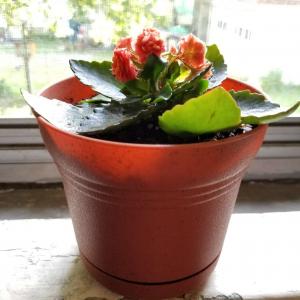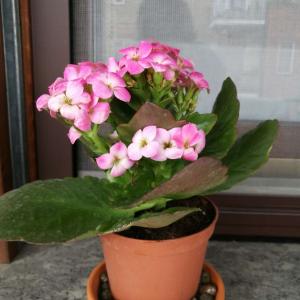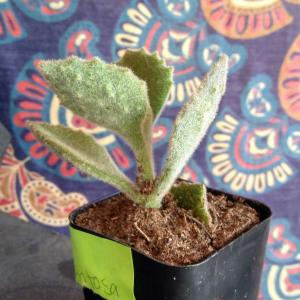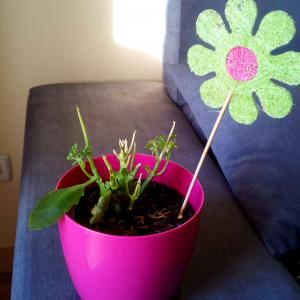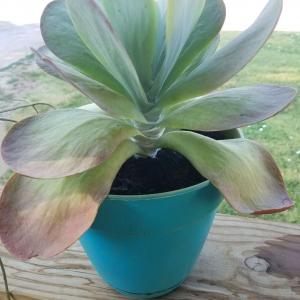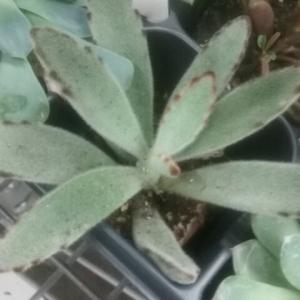文章
Dummer. ゛☀
2017年08月13日

It is easy to grow the Kalanchoe chandelier plant — so easy, in fact, you have to learn to control its spread as a part of caring for chandelier plants. Growing Kalanchoe delagoensis can be worth all this trouble when you learn how to keep it under control, especially when the orange blooms appear. Kalanchoe delagoensis, also known as Kalanchoe chandelier or mother of millions (and is often confused with mother of thousands, Kalanchoe daigremontiana), is an upright succulent with creeping tendrils bunching together on a single stem. This offers an unusual effect in the container or even in a portion of the sunny garden. Kalanchoe chandelier is hardy in drought stricken, desert areas where thriving plant life may be limited. This Kalanchoe species can exist on limited seasonal rainfall, storing water for existence due to succulent capabilities.
How to Grow Kalanchoe
For those with more hospitable conditions, learning how to grow Kalanchoe and keep it within bounds may include growing it in a large container or even as a houseplant. While drought and heat resistant, the plant is also adaptable to moist growing conditions and will often recover from a mild winter freeze. Chandelier plant care often includes removing small plants that have jumped from the container into the ground or another pot. This happens because Kalanchoe chandelier forms small plantlets at the ends of the leaves. When these are dislodged, they immediately take root and begin growing in any available soil. Removing them from unwanted areas is an integral part of caring for chandelier plants. Propagating Kalanchoe delagoensis is simple. In the event you don’t have more new starts than you need, new plants can be easily started from almost any part of the mother plant.
Dangers of Growing Kalanchoe Delagoensis
A danger when growing Kalanchoe chandelier is primarily to pets and wildlife because of toxins, called bufadienolides, that can cause heart failure when ingested. Animals not accustomed to the specimen may not realize the potential danger and test the plant for its culinary properties. Some gardeners find the attractive, orange blossoms worth the risk. If you choose to grow this unusual plant in a container or as part of an outdoor display, keep it out of reach of your pets or behind a small fence to discourage harm to your animals and visiting wildlife.
When not properly kept under control, this plant can quickly become invasive in southern parts of the United States and more southern areas, taking area that should be left for native plants. The responsible gardener will practice appropriate chandelier plant care when choosing to grow this specimen. Container growing is often the safest and easiest way to grow this plant. Now that you’ve learned how to grow this Kalanchoe and how to keep it in bounds and under control, make an informed decision before adding it to your landscape.

How to Grow Kalanchoe
For those with more hospitable conditions, learning how to grow Kalanchoe and keep it within bounds may include growing it in a large container or even as a houseplant. While drought and heat resistant, the plant is also adaptable to moist growing conditions and will often recover from a mild winter freeze. Chandelier plant care often includes removing small plants that have jumped from the container into the ground or another pot. This happens because Kalanchoe chandelier forms small plantlets at the ends of the leaves. When these are dislodged, they immediately take root and begin growing in any available soil. Removing them from unwanted areas is an integral part of caring for chandelier plants. Propagating Kalanchoe delagoensis is simple. In the event you don’t have more new starts than you need, new plants can be easily started from almost any part of the mother plant.

Dangers of Growing Kalanchoe Delagoensis
A danger when growing Kalanchoe chandelier is primarily to pets and wildlife because of toxins, called bufadienolides, that can cause heart failure when ingested. Animals not accustomed to the specimen may not realize the potential danger and test the plant for its culinary properties. Some gardeners find the attractive, orange blossoms worth the risk. If you choose to grow this unusual plant in a container or as part of an outdoor display, keep it out of reach of your pets or behind a small fence to discourage harm to your animals and visiting wildlife.

When not properly kept under control, this plant can quickly become invasive in southern parts of the United States and more southern areas, taking area that should be left for native plants. The responsible gardener will practice appropriate chandelier plant care when choosing to grow this specimen. Container growing is often the safest and easiest way to grow this plant. Now that you’ve learned how to grow this Kalanchoe and how to keep it in bounds and under control, make an informed decision before adding it to your landscape.
0
0
文章
Dummer. ゛☀
2017年08月13日

Growing mother of thousands (Kalanchoe daigremontiana) provides an attractive foliage houseplant. Though rarely blooming when kept indoors, the flowers of this plant are insignificant, with the most interesting feature being the baby plantlets continually appearing on the tips of the large leaves. When growing mother of thousands as an outdoor plant in USDA hardiness zones 9 -11, it may bloom with small, grayish lavender flowers in late winter. The mother plant then dies, but is replaced by tiny plantlets thatcan drop and cause the plant to be considered invasive. For this reason, most gardeners find growing mother of thousands works best in a container.Mother of Thousands Plant Info
Mother of thousands is of the Crassulaceae family and is related to jade plant and Flaming Katy (Kalanchoe blossfeldiana). It is often confused with the chandelier plant (Kalanchoe delagoensis) but shares similar growing conditions and traits. According to mother of thousands plant info, Kalanchoe daigremontiana has lost the ability to produce seeds and only reproduces from plantlets. As it is an abundant producer, it can quickly get out of hand when dropping these baby plantlets. While this provides numerous plants for the propagating gardener, those uninterested in the addition of more plants may find caring for mother of thousands a bit tedious. Don’t worry about disposing of the plantlets though, because more are sure to appear on the healthy, still growing mother of thousands. This succulent plant can resist drought, though performance is better when regularly watered. Like its relatives, Kalanchoe daigremontiana, does not need frequent fertilization. If you wish to feed when experimenting with how to grow Kalanchoe plants, do so only once every few months.
Caring for a Mother of Thousands
This plant does need good drainage and is best potted in a commercial cactus soil mix. If using standard potting soil, sand can be added for sharper drainage. When learning how to grow Kalanchoe indoors, locate the plant in bright, but indirect light for several hours per day. When growing Kalanchoe outdoors, avoid direct afternoon sun. Houseplants will benefit from spending the summer outside; just make sure to introduce them to the outside atmosphere gradually and begin their outdoor stay with limited morning sun. Too much direct sunlight may cause leaves to become sunburned. Remember to move the plant back inside before outdoor temperatures drop to the 40 degree F. range. (4 C.).
You’ll find that growing mother of thousands is simple and mostly carefree – a worthwhile gardening experience with limited care to keep it under control.
Mother of thousands is of the Crassulaceae family and is related to jade plant and Flaming Katy (Kalanchoe blossfeldiana). It is often confused with the chandelier plant (Kalanchoe delagoensis) but shares similar growing conditions and traits. According to mother of thousands plant info, Kalanchoe daigremontiana has lost the ability to produce seeds and only reproduces from plantlets. As it is an abundant producer, it can quickly get out of hand when dropping these baby plantlets. While this provides numerous plants for the propagating gardener, those uninterested in the addition of more plants may find caring for mother of thousands a bit tedious. Don’t worry about disposing of the plantlets though, because more are sure to appear on the healthy, still growing mother of thousands. This succulent plant can resist drought, though performance is better when regularly watered. Like its relatives, Kalanchoe daigremontiana, does not need frequent fertilization. If you wish to feed when experimenting with how to grow Kalanchoe plants, do so only once every few months.

Caring for a Mother of Thousands
This plant does need good drainage and is best potted in a commercial cactus soil mix. If using standard potting soil, sand can be added for sharper drainage. When learning how to grow Kalanchoe indoors, locate the plant in bright, but indirect light for several hours per day. When growing Kalanchoe outdoors, avoid direct afternoon sun. Houseplants will benefit from spending the summer outside; just make sure to introduce them to the outside atmosphere gradually and begin their outdoor stay with limited morning sun. Too much direct sunlight may cause leaves to become sunburned. Remember to move the plant back inside before outdoor temperatures drop to the 40 degree F. range. (4 C.).

You’ll find that growing mother of thousands is simple and mostly carefree – a worthwhile gardening experience with limited care to keep it under control.
2
0
文章
Dummer. ゛☀
2017年08月13日

I received a Kalanchoe as a gift plant this summer and I am now struggling to get it to bloom anew. Kalanchoe is an African native that has become a common house guest in North American homes. These plants require low light conditions to force budding. Ideally, the plant should experience 14 hours of lightless conditions to promote budding and bloom. Getting Kalanchoe to bloom again requires a bit of a rest period for the plant, correct lighting and some good fertilizer to fuel the process. A few tips on how to make a Kalanchoe rebloom will ensure success and a beautiful flowering houseplant in winter. 
Kalanchoe Bloom Time
Usually, the plant is in full bloom at purchase and produces a constant parade of flowers for weeks or even months. Kalanchoes are forced to bloom by nurseries, in order to present their flowers for purchasers. When does Kalanchoe bloom naturally? In its native region, Kalanchoe can bloom almost year around, but as a container houseplant, it is most commonly blooming in late winter to late spring. This cycle will slow down as lighting increases.
Getting a Kalanchoe to bloom again requires a rest period for the plant and then tricking it into thinking it is a different time of year. Exposure to lower light levels during fall and winter will generally encourage the plant to bloom, but plants in higher light regions will need some closet time to mimic the lower light hours of a winter hibernation. A hibernation, or rest period, is necessary for the plant to amass energy for blooming and growth when conditions are favorable. Keeping the plant in no light for this period will awaken the plant from its winter slumber and cause flower production. Failing to provide a rest period is often the reason getting Kalanchoe to bloom again may be unsuccessful.
How to Make a Kalanchoe Rebloom
After the flowers on your plant begin to fade and die, cut them back and remove the spent blooms. This prevents the plant from directing energy to trying to sustain a part that is already spent. During the summer, keep the plant in well-drained soil in a sunny location and maintain a moderate moisture level. When fall arrives, cut back on water and move the plant indoors if you are in a zone below USDA 9 or where frost is expected. The plant will experience low light conditions from fall to late winter, which normally causes flowers to form. Fertilize with a 0-10-10 in late winter or just as the first buds are forming. This will promote better and more Kalanchoe flowering and enhance plant health and vigor.
Tricking a Kalanchoe into Blooming
If you want your plant to bloom at a specific time, such as Christmas, you will need to do some planning. Minimize watering and give the plant a 14-hour period without light daily 6 weeks before the desired bloom time. Place the plant in a closet or under a box for 14 hours and provide 10 hours of bright light. Keep the plant warm and away from drafts. Do not water or feed the plant for 6 weeks, as it is dormant. As soon as you see flower buds, move the plant to brighter lighting and resume watering. Feed the plant in spring and remove spent flowers to encourage new buds. These plants are easy to grow and provide up to 6 months of beautiful little flowers and thick attractively scalloped leaves.

Kalanchoe Bloom Time
Usually, the plant is in full bloom at purchase and produces a constant parade of flowers for weeks or even months. Kalanchoes are forced to bloom by nurseries, in order to present their flowers for purchasers. When does Kalanchoe bloom naturally? In its native region, Kalanchoe can bloom almost year around, but as a container houseplant, it is most commonly blooming in late winter to late spring. This cycle will slow down as lighting increases.
Getting a Kalanchoe to bloom again requires a rest period for the plant and then tricking it into thinking it is a different time of year. Exposure to lower light levels during fall and winter will generally encourage the plant to bloom, but plants in higher light regions will need some closet time to mimic the lower light hours of a winter hibernation. A hibernation, or rest period, is necessary for the plant to amass energy for blooming and growth when conditions are favorable. Keeping the plant in no light for this period will awaken the plant from its winter slumber and cause flower production. Failing to provide a rest period is often the reason getting Kalanchoe to bloom again may be unsuccessful.

How to Make a Kalanchoe Rebloom
After the flowers on your plant begin to fade and die, cut them back and remove the spent blooms. This prevents the plant from directing energy to trying to sustain a part that is already spent. During the summer, keep the plant in well-drained soil in a sunny location and maintain a moderate moisture level. When fall arrives, cut back on water and move the plant indoors if you are in a zone below USDA 9 or where frost is expected. The plant will experience low light conditions from fall to late winter, which normally causes flowers to form. Fertilize with a 0-10-10 in late winter or just as the first buds are forming. This will promote better and more Kalanchoe flowering and enhance plant health and vigor.

Tricking a Kalanchoe into Blooming
If you want your plant to bloom at a specific time, such as Christmas, you will need to do some planning. Minimize watering and give the plant a 14-hour period without light daily 6 weeks before the desired bloom time. Place the plant in a closet or under a box for 14 hours and provide 10 hours of bright light. Keep the plant warm and away from drafts. Do not water or feed the plant for 6 weeks, as it is dormant. As soon as you see flower buds, move the plant to brighter lighting and resume watering. Feed the plant in spring and remove spent flowers to encourage new buds. These plants are easy to grow and provide up to 6 months of beautiful little flowers and thick attractively scalloped leaves.
1
3
文章
Dummer. ゛☀
2017年08月13日

What is a paddle plant? Also known as flapjack paddle plant (Kalanchoe thyrsiflora), this succulent kalanchoe plant has with thick, rounded, paddle-shaped leaves. The plant is also known as red pancake because the leaves frequently take on a reddish or deep pink tint during the winter. Read on for tips on growing paddle plants.
How to Grow a Flapjack Paddle Plant
Growing paddle plants outdoors is possible in USDA plant hardiness zones 10 and above, but gardeners in cooler climates can grow kalanchoe as an indoor plant.
Water kalanchoe only when the soil is dry. When watering indoor plants, allow the pot to drain completely before replacing the plant on its drainage saucer. Never overwater, as kalanchoe, like all succulents, is prone to rot in soggy soil. Water kalanchoe sparingly during the winter months. Outdoors, kalanchoe plants do well in full sunlight or light shade. Indoor plants perform best in bright light. However, avoid direct light during the summer months, as too much intense light may scorch the plant. Paddle plant prefers temperatures between 60 and 85 F. (16-29 C.). Avoid temperatures below 60 F. (16 C).
Outdoor plants require well-drained soil to prevent rotting. Indoor plants need a well-drained potting mix. A handful of sand is helpful, or you can use a potting mix formulated specifically for cacti and succulents. Alternatively, create your own mix by combining peat moss, compost and coarse sand. Fertilize paddle plant lightly during the growing season. Withhold fertilizer during fall and watering for both indoor and outdoor plants.
Paddle Plant Propagation
The easiest way to propagate kalanchoe is to plant leaves or leaf cuttings in spring or summer. Set leaves or cuttings aside for a couple of days, or until the cut end develops a callus. You can also remove offsets that grow on the side of a mature paddle plant. Plant the leaves or offsets in a small pot filled with lightly moistened potting mix for cacti and succulents. Keep the potting mix evenly and lightly moist but never soggy. Bright, indirect sunlight is best for paddle plant propagation. Once the plant is established and shows healthy new growth, you can treat it as a mature plant.

How to Grow a Flapjack Paddle Plant
Growing paddle plants outdoors is possible in USDA plant hardiness zones 10 and above, but gardeners in cooler climates can grow kalanchoe as an indoor plant.
Water kalanchoe only when the soil is dry. When watering indoor plants, allow the pot to drain completely before replacing the plant on its drainage saucer. Never overwater, as kalanchoe, like all succulents, is prone to rot in soggy soil. Water kalanchoe sparingly during the winter months. Outdoors, kalanchoe plants do well in full sunlight or light shade. Indoor plants perform best in bright light. However, avoid direct light during the summer months, as too much intense light may scorch the plant. Paddle plant prefers temperatures between 60 and 85 F. (16-29 C.). Avoid temperatures below 60 F. (16 C).

Outdoor plants require well-drained soil to prevent rotting. Indoor plants need a well-drained potting mix. A handful of sand is helpful, or you can use a potting mix formulated specifically for cacti and succulents. Alternatively, create your own mix by combining peat moss, compost and coarse sand. Fertilize paddle plant lightly during the growing season. Withhold fertilizer during fall and watering for both indoor and outdoor plants.

Paddle Plant Propagation
The easiest way to propagate kalanchoe is to plant leaves or leaf cuttings in spring or summer. Set leaves or cuttings aside for a couple of days, or until the cut end develops a callus. You can also remove offsets that grow on the side of a mature paddle plant. Plant the leaves or offsets in a small pot filled with lightly moistened potting mix for cacti and succulents. Keep the potting mix evenly and lightly moist but never soggy. Bright, indirect sunlight is best for paddle plant propagation. Once the plant is established and shows healthy new growth, you can treat it as a mature plant.
0
0
文章
Dummer. ゛☀
2017年08月13日

Kalanchoe plants are thick leaved succulents that are often seen in florist shops or garden centers. Most end up as potted plants but areas that can mimic their native land of Madagascar can grow them outdoors. The clusters of tiny flowers produce a large bloom held aloft on stems above the majority of the foliage. If you wish a second bloom, it is incumbent to know how to take care of a kalanchoe. These plants need short winter light periods to form new buds. Learn how to grow kalanchoe and the perennial can reward you with several seasons of the bright colorful flowers.
About Kalanchoe Plants
The deep green, scalloped leaves of the kalanchoe are just as attractive as the flowers. The sculpted foliage persists after bloom and provides for a handsome plant. The starry flowers are long lasting and bloom in winter to spring. Kalanchoe plants require well-drained soil and mild temperatures of at least 60 F. (16 C.). Little maintenance is necessary for kalanchoe care and the succulent has few disease or pest problems, especially when grown indoors.
How to Grow Kalanchoe Cuttings
Kalanchoe plants are fun to grow from cuttings. The vegetative stems produce the best plants and root quickest. Take a 2- to 3-inch section and strip off the bottom couple of leaves. Let the cutting sit out in a warm, dry location to form a callus on the end. Plant the cutting in pre-moistened peat and perlite up to the first leaf. Enclose the entire pot in plastic to form a little terrarium and conserve the moisture. Place the pot in a bright window with indirect light. Cuttings will root in 14 to 21 days and are then ready to transplant.
How to Take Care of a Kalanchoe
Plants may grow well in southern Florida year round or outside in USDA zones 8 to 10 during the summer months. Kalanchoe care is minimal but be cautious about light levels. Strong southern light can burn the tips of the leaves. Place pots in partial sun to light shade areas when growing kalachoe plants. The best planting mix is 60 percent peat moss and 40 percent perlite. Cut off spent flower stems and pinch back leggy growth to force a compact plant. Water the plant deeply and then allow it to dry out completely before you give it further moisture. Fertilize once per month during the growing season with a houseplant food.
Kalanchoe Care for Second Bloom
Although the plant foliage of growing kalanchoe succulent plants is interesting even without blooms, the flowers make the most spectacular display. To force the plant to bloom again, you must fool it into believing it has experienced winter. During October and early March, the day lengths are short enough to naturally force flower buds. In other periods, you will have to put the plant in a closet or dim room for most of the day. Bring it out only for morning light and then put it away after a few hours. The plant needs six weeks of 12 to 14 hour darkness to form spectacular new flowers. The best temperatures for formation of flowers are 40-45 F. (4-7 C.) at night and 60 F. (16 C.) during the day. Kalanchoe care for plants that have begun to form buds is the same as that for flowering plants.

About Kalanchoe Plants
The deep green, scalloped leaves of the kalanchoe are just as attractive as the flowers. The sculpted foliage persists after bloom and provides for a handsome plant. The starry flowers are long lasting and bloom in winter to spring. Kalanchoe plants require well-drained soil and mild temperatures of at least 60 F. (16 C.). Little maintenance is necessary for kalanchoe care and the succulent has few disease or pest problems, especially when grown indoors.

How to Grow Kalanchoe Cuttings
Kalanchoe plants are fun to grow from cuttings. The vegetative stems produce the best plants and root quickest. Take a 2- to 3-inch section and strip off the bottom couple of leaves. Let the cutting sit out in a warm, dry location to form a callus on the end. Plant the cutting in pre-moistened peat and perlite up to the first leaf. Enclose the entire pot in plastic to form a little terrarium and conserve the moisture. Place the pot in a bright window with indirect light. Cuttings will root in 14 to 21 days and are then ready to transplant.

How to Take Care of a Kalanchoe
Plants may grow well in southern Florida year round or outside in USDA zones 8 to 10 during the summer months. Kalanchoe care is minimal but be cautious about light levels. Strong southern light can burn the tips of the leaves. Place pots in partial sun to light shade areas when growing kalachoe plants. The best planting mix is 60 percent peat moss and 40 percent perlite. Cut off spent flower stems and pinch back leggy growth to force a compact plant. Water the plant deeply and then allow it to dry out completely before you give it further moisture. Fertilize once per month during the growing season with a houseplant food.
Kalanchoe Care for Second Bloom
Although the plant foliage of growing kalanchoe succulent plants is interesting even without blooms, the flowers make the most spectacular display. To force the plant to bloom again, you must fool it into believing it has experienced winter. During October and early March, the day lengths are short enough to naturally force flower buds. In other periods, you will have to put the plant in a closet or dim room for most of the day. Bring it out only for morning light and then put it away after a few hours. The plant needs six weeks of 12 to 14 hour darkness to form spectacular new flowers. The best temperatures for formation of flowers are 40-45 F. (4-7 C.) at night and 60 F. (16 C.) during the day. Kalanchoe care for plants that have begun to form buds is the same as that for flowering plants.
1
1
成长记
SucculentLover021815
2017年08月11日

I new added a "Kalanchoe Tomentosa 'Panda Plant'" in my "garden"
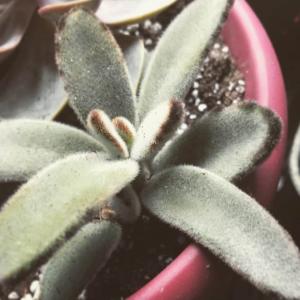

0
0
文章
Miss Chen
2017年08月08日


With large paddle-shaped fleshy green leaves edged in red, flapjack kalanchoe (Kalanchoe thyrsiflora), more commonly called simply flapjack, it makes a visual splash in the garden. It grows between 10 inches and 2 feet tall in a rosette pattern with the leaves growing out of the center stalk. Flapjack grows outdoors in U. S. Department of Agriculture plant hardiness zones 9 through 11 or as a houseplant. You can also treat it as an annual in cooler climates. A low-maintenance perennial succulent, flapjack needs minimal care to thrive.
Fertilize Sparingly
Fertilize flapjack two to four times per year with the first application in the spring when new growth starts. Apply the last fertilizer in the fall then stop through the winter. Use a slow-release, balanced fertilizer, such as a 10-10-10 product, to supply continuous nutrients between feedings. Use 1 tablespoon for each 1 square foot of area around each plant. For larger beds, use 1 cup per 30 for each square feet.
Water Lightly
Flapjack is a drought-tolerant succulent. Allow the soil to dry out on top between waterings. When watering, soak the soil 6 inches deep.
Container Growing
Flapjack grows well in pots, either indoors or outside. Indoors, set the bots in a bright room with indirect light, ideally in a spot between 50 and 50 degrees Fahrenheit. Outside, keep the pots in a sunny area of the patio or porch or set the planters in the garden.
Fertilizing Container Plants
Fertilize a container-grown flapjack every other week with 1/2 teaspoon of balanced 15-15-15 fertilizer. Mix the fertilizer into 1 gallon of water and use it to water the plant.

Watering Container Plant
Water a flapjack in a planter until the soil is thoroughly damp and extra water starts to leak out the drainage holes in the bottom, then wait to water until the top of the soil looks dry.
Overwintering Indoors
In USDA zones 9 and below, grow flapjack in planters outdoors in the summer and overwinter them inside. In fall, before the first freeze, move the pots to a sunny spot that stays between 50 and 60 F. Stop fertilizing for the winter and water only when the soil feels dry. In spring, after the last frost, return the container-grown flapjack outside.
Pests and Problems
Flapjack doesn't attract pests and rarely suffers from diseases and other problems.
Pruning and Trimming
This tidy succulent doesn't require any pruning or trimming during or after the growing season. The only exception is the flower stalk. After the flapjack flowers, cut out the dead flower stalk where it attaches to the main plant. Flapjack is grown as a foliage plant, and flowers only appear after three to four years, so in general you can get by without any pruning.
1
1
求助
Potatoizaplant
2017年07月29日

I NEED HELP WITH MY KALANCHOE PLANT PLEASE! I bought this little guy a few months ago and it bloomed for my a few days after i bought it. It was fine until l 3 weeks later when i noticed the leaves shriveling up. It continued to lose it leaves and I pruned the flowers so it can focus all its energy on regaining its health. During the past few months I've repoted the plant, checking for root rot or any pest and i found nothing. Ive changed waterings, light, anything you can think off and it continues to loose it leaves. If you guys can help me save this plant, please comment any suggestions!
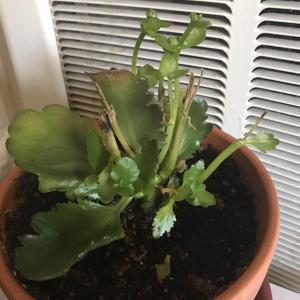

2
0
meriunkat:well all I know is that I water mine when the soil is dry which could be about every three days..and gradually exposed to sunlight
lizhufun:当金银花蕾生虫蛋如何处治



